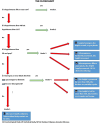Tracing the disc: The novel qualitative morphometric MRI based disc degeneration classification system
- PMID: 38500784
- PMCID: PMC10945309
- DOI: 10.1002/jsp2.1321
Tracing the disc: The novel qualitative morphometric MRI based disc degeneration classification system
Abstract
Background: This study aimed to develop a classification system for lumbar disc degeneration using routine magnetic resonance images (MRIs) that is easily applicable and unaffected by existing classifications' limitations, and to compare its reliability, reproducibility, and discriminative power to the widely used Pfirrmann classification.
Methods: Five features were graded. This new classification system has eight grades, with at least one of these five features altering each grade. The T2-weighted sagittal images were acquired using a rapid spin-echo sequence with a repetition time of 2680 to 4900 milliseconds, an echo time of 100 to 109 milliseconds, and an echo train length of 17. Slice thick was 4 mm and the display field of view was 32 × 32 cm. The new classification system used five features: signal intensity, disc height, disc boundary regularity, and nucleus annulus separation. Increased signal intensity, decreased height, decreased regularity, and decreased nucleus-annulus separation indicated degeneration. Four raters classified 400 discs from 80 patients using the Pfirrmann and Novel systems. Statistical analyses were conducted to investigate reliability and correlation.
Results: The overall ICC and kappa values were found to be higher in the novel classification. (0.988 indicating excellent agreement for ICC and 0.76/0.94 indicating good-very good agreement for kappa). The Kendall tau c value, which shows the correlation between the two classifications and indicates the validity of the new classification, was 0.872, which is very strong. Through the use of cross-tabulations, the discriminatory power of the two newly added classification criteria was determined.
Conclusions: This study demonstrates the intra-rater and inter-rater reliability of an easy-to-use, discriminative novel morphometric MRI based classification system for lumbar disc degeneration. The differentiation of grades based on five distinct criteria may generate novel hypotheses regarding treatment selection and response monitoring, as well as new insights into the study of disc degeneration.
Keywords: MRI; disc degeneration; novel morphometric classification; reliability tests.
© 2024 The Authors. JOR Spine published by Wiley Periodicals LLC on behalf of Orthopaedic Research Society.
Conflict of interest statement
The authors declare no conflicts of interest.
Figures



References
-
- Hartvigsen J, Hancock MJ, Kongsted A, et al. What low back pain is and why we need to pay attention. Lancet. 2018;391(10137):2356‐2367. - PubMed
-
- Hoy D, Bain C, Williams G, et al. A systematic review of the global prevalence of low back pain. Arthritis Rheum. 2012;64(6):2028‐2037. - PubMed
-
- Vergroesen PP, Kingma I, Emanuel KS, et al. Mechanics and biology in intervertebral disc degeneration: a vicious circle. Osteoarthr Cartil. 2015;23(7):1057‐1070. - PubMed
-
- GBD 2013 DALYs and HALE Collaborators , Murray CJ, Barber RM, et al. Global, regional, and national disability‐adjusted life years (DALYs) for 306 diseases and injuries and healthy life expectancy (HALE) for 188 countries, 1990–2013: quantifying the epidemiological transition. Lancet. 2015;386(10009):2145‐2191. - PMC - PubMed
LinkOut - more resources
Full Text Sources

